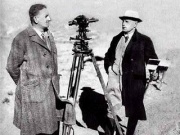Posnansky Arthur
Da Ufopedia.
(→Writings) |
|||
| Riga 6: | Riga 6: | ||
== Writings == | == Writings == | ||
| - | In 1943 Posnansky published his final and most important book ''Tihuanacu, the Cradle of American Man''. In this book Posnansky argued that Tiwanaku was constructed approximately 12,000 years previously by American peoples, although not by the ancestors of those then living in the area, the Aymara. Posnansky also saw Tiwanaku as the origin point of civilization throughout the Americas, including the Inca, the Maya and others. Both these ideas have since been challenged by archaeological research | + | In 1943 Posnansky published his final and most important book ''Tihuanacu, the Cradle of American Man''. In this book Posnansky argued that Tiwanaku was constructed approximately 12,000 years previously by American peoples, although not by the ancestors of those then living in the area, the Aymara. Posnansky also saw Tiwanaku as the origin point of civilization throughout the Americas, including the Inca, the Maya and others. Both these ideas have since been challenged by archaeological research. This culture probably began at between 1500 and 1400 B.C. and collapsed at around the year 1100 to 1200 A.D. |
== Later life == | == Later life == | ||
Versione delle 20:07, 1 feb 2010
Arthur Posnansky (1873 - 1946), often called "Arturo", was a Bolivian engineer, explorer and archaeologist. He best remembered for popularizing the archaeological site of Tiwanaku. He was born in Vienna on April 13, 1873 and died in La Paz, Bolivia in 1946.
Posnansky was known as a prolific writer and researcher. He was self-taught archaeologist and also wrote ethnography. He was a member and later President of the Sociedad Geografica de Bolivia, based in La Paz.
Indice |
Writings
In 1943 Posnansky published his final and most important book Tihuanacu, the Cradle of American Man. In this book Posnansky argued that Tiwanaku was constructed approximately 12,000 years previously by American peoples, although not by the ancestors of those then living in the area, the Aymara. Posnansky also saw Tiwanaku as the origin point of civilization throughout the Americas, including the Inca, the Maya and others. Both these ideas have since been challenged by archaeological research. This culture probably began at between 1500 and 1400 B.C. and collapsed at around the year 1100 to 1200 A.D.
Later life
Outside of Bolivia, where he is still widely read, Posnansky's writings have also been made popular by writers such as Graham Hancock, who rely on Posnansky's dating of the site to support their theories.
As an engineer, Arthur Posnansky is also remembered for introducing the first car to Bolivia, and for being involved in the military dispute between Bolivia and Brazil over the territory of the Acre.
Libros
- Razas y monumentos prehistóricos del altiplano andino. (1911)
- Una Metrópoli Prehistórica en la América del Sud. Tomo I (1914)
- Antropología y sociología de las razas interandinas y de las regiones adyacentes. (1938)
- Qué es raza. (1943)
- Primer nueva crónica y buen gobierno escrita entre 1584-1614. (1944)
- Tihuanacu, la cuna del hombre americano (1945)
References
Ponce Sangines, Carlos. Arthur Posnansky: Biografia Intelectual de un Pionero. La Paz: Producciones "CIMA", 1999.
